 W
WThe Alfa Romeo 90 is an executive car produced by Italian car manufacturer Alfa Romeo between 1984 and 1987.
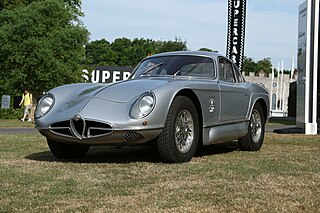 W
WThe Alfa Romeo 2000 Sportiva is a 2-litre sports car made by Italian car manufacturer Alfa Romeo in 1954. Although developed to be built in a small series, just four were made — two coupés and two spiders.
 W
WThe Alfa Romeo 2600 was Alfa Romeo´s six-cylinder flagship produced from 1962 to 1968. It was the successor to the Alfa Romeo 2000. It has become historically significant as the last Alfa Romeo to have been fitted with an inline six-cylinder engine with twin overhead camshafts. That had been the traditional Alfa Romeo engine configuration since the 1920s, but gave way to four-cylinder engines as the factory oriented its production towards more economical mass-produced car models starting in 1950.
 W
WThe Alfa Romeo BAT are a series of Italian concept cars. The cars originated from a joint collaboration project between Alfa Romeo and the Italian design house Bertone that began in 1953. Three cars were built: the BAT 5 in 1953, the BAT 7 in 1954, and finally the BAT 9 in 1955. All three cars were designed by Franco Scaglione.
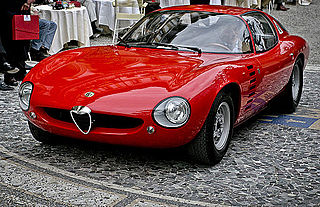 W
WThe Alfa Romeo Canguro is a concept car designed by Giorgetto Giugiaro at Bertone. The car is based on the chassis of an Alfa Romeo TZ and was shown at the 1964 Paris Motor Show. The body is made of fiberglass rather than aluminium and it features one of the first glued in windscreens in a car. The name "Canguro" means Kangaroo in Italian.
 W
WThe Alfa Romeo GT is a coupe automobile that was produced by the Italian automaker Alfa Romeo between 2003 and 2010. The GT was introduced in March 2003 at the Geneva Motor Show. Production commenced on 28 November 2003, the GT was built at the Pomigliano plant, alongside the 147 and 159. A total of 80,832 units were produced.
 W
WThe Alfa Romeo Montreal is a 2+2 coupé sports car produced by the Italian manufacturer Alfa Romeo from 1970 to 1977.
 W
WASA was an Italian automobile manufacturer active from 1961 to 1969, who is known for manufacturing the ASA 1000 GT. This car was developed by Ferrari engineers in the late 1950s as a less expensive, compact alternative to existing Ferrari GT cars. ASA used inline-four and straight-six engines derived from the "250" 3-litre V12 designed by Gioacchino Colombo. The chassis was developed by Giotto Bizzarrini and was derived from the tubular frame chassis of the 250 GTO.
 W
WThe car was revealed at the 1961 Geneva Motor Show by Gruppo Bertone and was designed by Giorgetto Giugiaro who was only 22 years old at the time. It was based on the Aston Martin DB4 GT and was originally finished in light green and had a grey interior.
 W
WThe Bertone Nuccio is a concept car designed and developed by the Italian design house Bertone to celebrate the company's 100th anniversary. It was first shown to the public at the 2012 Geneva Motor Show and was the last car designed by Bertone to have the Bertone name, and was the second-last car designed by Bertone before its bankruptcy in 2014.
 W
WThe Bertone Blitz is an electric sports car produced in 1992 by the company Bertone, which worked under Ferrari. It is propelled from 0 to 62 mph in six seconds via two 36 horsepower (27 kW) DC motors applying a combined total of 95 Nm (70 ft·lbf) of torque. It has a weight of 650 kg (1433 lb), 260 kg (572 lb) of that weight is in lead acid batteries. The typical range of this battery electric vehicle is 60 to 80 miles per charge and it can be recharged within 4 to 6 hours.
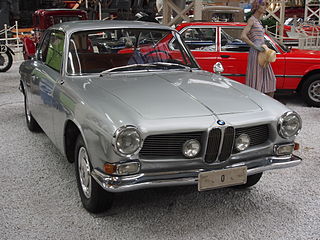 W
WThe BMW 3200 CS was a sports touring car manufactured by BMW between January 1962 and September 1965. It was designed by Bertone and was introduced at the 1961 Frankfurt Motor Show. More than five hundred were built.
 W
WThe Citroën Xantia, pronounced "Zan–ti–a" is a large family car (D) produced by the French automaker Citroën, and designed by Bertone. Presented to the press in December 1992, the car was produced between 1992 and 2002 in Europe, with a facelift in the end of 1997.
 W
WThe Dino 308 GT4 and 208 GT4 were mid-engined V8 2+2 cars built by Ferrari. The Dino 308 GT4 was introduced in 1973 and supplemented by the 208 GT4 in 1975. The cars were sold with Dino badging until May 1976, when they received Ferrari badging. The GT4 was replaced by the Mondial 8 in 1980 after a production run of 2,826 308s and 840 208s.
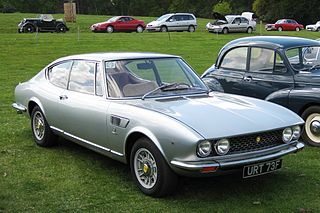 W
WThe Fiat Dino was a front-engine, rear-wheel-drive sports car produced by Fiat from 1966 to 1973. The Dino name refers to the Ferrari Dino V6 engine, produced by Fiat and installed in the cars to achieve the production numbers sufficient for Ferrari to homologate the engine for Formula 2 racing.
 W
WThe Fiat Punto is a supermini car produced by the Italian manufacturer Fiat from 1993 to 2018, spanning over three generations. The third generation of the car was marketed as the Grande Punto, between 2005 and 2009, and as the Punto Evo, between 2009 and 2012, when the single-word Punto name was reintroduced. As of May 2013, nearly nine million units had been sold globally.
 W
WGordon-Keeble was a British car marque, made first in Slough, then Eastleigh, and finally in Southampton, between 1964 and 1967. The marque's badge was unusual in featuring a tortoise — a pet tortoise walked into the frame of an inaugural photo-shoot, taken in the grounds of the makers. Because of the irony the animal was chosen as the emblem.
 W
WThe Innocenti 186 GT is a sports car jointly developed by Italian car manufacturers Innocenti and Ferrari in 1963–64, but never put into production. Just two prototypes were ever built, and one survives today.
 W
WThe Iso Lele is a grand tourer that was produced by the Italian automobile manufacturer Iso Automoveicoli S.p.A. between 1969 and 1974. The Lele, being a 2+2-seater, filled the gap between the Grifo and the Fidia while sharing its powertrain with its siblings. The styling was done by Marcello Gandini of Bertone. The car is named after Lele Rivolta, wife of Piero Rivolta.
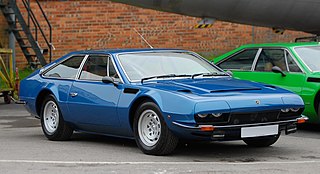 W
WThe Lamborghini Jarama is a 2+2 grand tourer manufactured and marketed by Italian car manufacturer Lamborghini between 1970 and 1976. It was styled by Bertone designer Marcello Gandini.
 W
WThe Lamborghini Silhouette P300 is a two-door two-seat mid-engined rear-wheel drive sports car, that was made in small numbers by Lamborghini between 1976 and 1979.
 W
WThe Lancia Stratos HF, widely and more known simply as Lancia Stratos, is a sports car and rally car made by Italian car manufacturer Lancia. The HF stands for High Fidelity. It was a very successful rally car, winning the World Rally Championship in 1974, 1975 and 1976; and race car winning 1974 Targa Florio, five times the Tour de France Automobile and three editions of Giro d'Italia automobilistico.
 W
WThe Maserati Khamsin is a grand tourer produced by Italian automobile manufacturer Maserati between 1974 and 1982. The Khamsin was sold alongside the DeTomaso-based Maserati Kyalami — also a V8 2+2 GT car - between 1976 and 1982.
 W
WThe Maserati Quattroporte is a four-door full-size luxury sports saloon produced by Italian automobile manufacturer Maserati. The name translated from Italian means "four doors". The car is currently in its sixth generation, with the first generation introduced in 1963.
 W
WThe Opel Astra is a compact car/small family car (C-segment) engineered and manufactured by the German automaker Opel since 1991, currently at its sixth generation. It was launched in September 1991 in hatchback, saloon, and station wagon forms. A sedan delivery/panel and a convertible also appeared in the early 1990s. These bodystyles were later followed by a coupé in 2004, the sporty Astra OPC appeared in 2005, the Twin Top retractable hardtop convertible replaced the soft top convertible in 2006, while the Caravan was rebadged Astra Sports Tourer from 2009 onwards.
 W
WThe Volvo 262C is the first luxury coupé made by Volvo. Based on the Volvo 200 Series, the 262C was built by Bertone in Turin for the 1977-1981 model years.